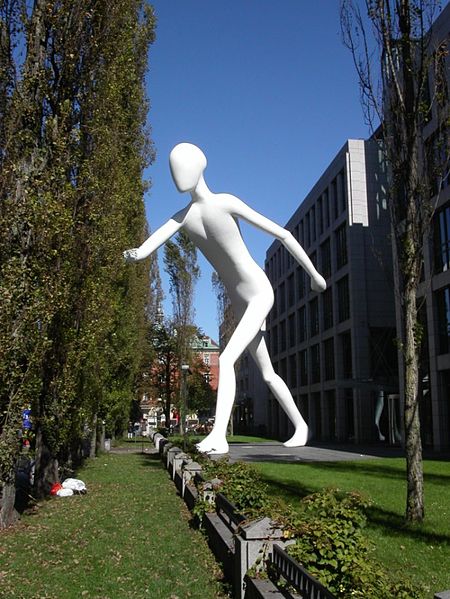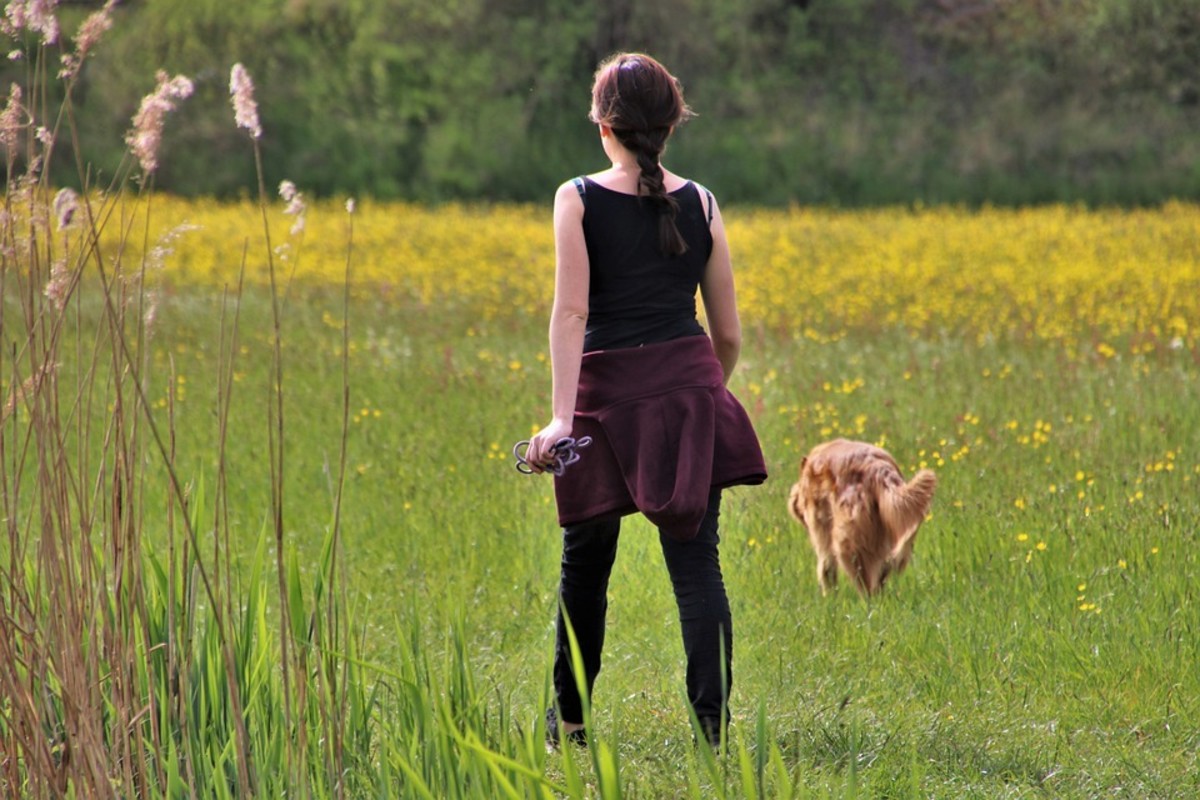Why Do We Swing Our Arms When We Walk
Swinging Arms and Walking

Walking Upright is Uniquely Human
The ability to walk upright is uniquely human, and sets us apart from well over 200 species of living primates. It is an obvious part of our evolution, and distinctly differentiates us from the apes. Once a child learns to walk, walking becomes our primary form of locomotion.
What your body does when you're working on your walking:
When we stand, we use very few muscles of our back and our lower limbs. Usually our hip and knee joints are extended and in a stable position. Walking is a complicated and complex activity, yet it is mostly done automaticlly. That is why disturbances in walking are indicative of some dysfunctions of the central nervous systems.
Here is a shortened version of some of the muscles and bones involved in walking. Walking involves moving the lower limbs, with a combination of swing and stance and striking our heel against the ground. First one foot, then the next foot. The muscles of the feet relax to lower the foot and then transfer weight through the foot and even to the big toe. Our knee is able to lock when our leg is fully extended and enables our weight to transfer to the ankle, which helps control our feet when they hit the ground.
Swinging Our Arms While Walking is Natural
Arm swinging is an obvious characteristic when people walk and run. When we walk and swing our arms we save energy that is needed to walk if our arms did not move while we are in motion. Moving our arms while we walk makes it easier for our legs too. The force by which we contact the ground increases by 63% if our arms are in motion.
Researchers have been trying to discover the explanation for arm swinging while we walk.
It used to be thought that swinging our arms was a vestige left over from an ancestors who walked on all fours. Biomechanincal engineers at the University of Michigan, discovered that swinging arms is a natural part of walking on 2 legs. Scientists discovered that arm swinging requires little effort from the muscles and is not muscle driven. It is part of the locomotion of the body moving and walking. In experiments, they discovered that people who kept the arms steady took more effort to walk.
People who moved their arms walked 20% faster. Swinging our arms is so natural, that letting them swing actually requires less energy than if you were to hold your arms down while walking.
The Benefits of Moving Our Arms and Walking
Our arms move in sync with our legs. If our arms swing out of sync with our legs, it made the effort of walking more difficult. Alternately moving our arms out of sync makes our legs work twice as hard. Scientists at Delft University in the Netherlands believe people who don’t swing their arms in conjunction with their legs, have the possibility of veering off course and putting a bigger burden on their body and energy.
While studying volunteers on a treadmill, scientists monitored their metabolism. People who moved their arm and leg on the same side used 26% more energy because our muscles battle to keep us on course.
The scientists hope to use this information to help patients who are learning to walk again after illness or injury.
Through observation, researchers have learned that arm swinging is a function of the movement from the lower part of our body, as opposed to being powered by our shoulders.
For quite a while the movement of our armswhile walking, baffled scientists because it seemed to play no obvious role or purpose. Using a mechanical model to see what arm swinging did, and using 10 volunteers who walked 3 different ways, with their arms swinging normally, with their arms at their side, and with their arms swinging in sync with each leg, scientists made several observations.
It took 12% more energy than if their arms were held still than if they moved them. When they moved their left arm with their left leg, and then their right arm and right leg, they used 26% more energy because their muscles worked harder to keep this motion going.
Swinging our arms also keeps our body balanced. By moving our arms, we can walk in a straighter path, and it helped us walk in a smoother motion.
Arm Movement and Parkinson's Disease
Scientists are now believing that people who move their arms irregularly, may be showing early signs of Parkinson’s disease. Neurologists think that this early detection might help doctors use treatments that could slow the damage to brain cells and buy some time until science comes up with ways to slow the progression of this disease. By watching the manner in which a person walks, they may see certain indicators of early onset of this disease. By observing people with Parkinson’s rearchers determined that they may swing their arms differently from each other. They may move one arm less than the other as they walk.
Early in the disease, it has been noted that people lose their arm swing. In a study done by Dr Xuemei Huang, associate professor of neurology, Penn State Hershey College of Medicine, they researched the relationship of this disease to walking. Researchers compared the arm swing of a dozen Parkinson’s patients, to 8 people who did not have this disease.
The individuals with Parkinson’s were told to stop taking medications the night before the research study was to be done. Special equipment was used to measure the movements with accuracy. A computer measured the degree of their arm swings and found that one arm swung much less than the other, no matter what speed they walked. Some people, when they walk may have slightly different arm swings, but those with Parkinson’s disease, had significant differences in their arm swings.
The disease is diagnosed in people suspected with Parkinson’s by tremors at rest amd stiffness in their limbs and their body. By the time the disease is diagnosed significant neurons have already been adversely affected. It is already well known that in the later stages of Parkinson’s disease, there are changes in a person’s walking pattern and gait.
Ahh... To Be Human
Walking is a gift few us may think about doing, unless we lose that ability. Very often we give little thought to this power of locomotion. Yet, the coordination of our brain, spinal cord, muscles and bones, and swinging of our arms is a complex process. Science is always looking to understand more about the human body. From yawning to hiccups, and many other things, science is looking to explain more about our anatomy.
From standing upright to moving from point to point, to the balance it takes to accomplish this activity, walking upright is unique and special to human beings, something we should be very grateful for.
What Do You Do?
Do You Move Your Arms While You Walk?
- Human Anatomy: Loving the Parts of Our Body We Rare...
The Human Anatomy and the Intricate Body Parts that help us be an Amazing Machine Read on to learn how these little thought about elements of the human anatomy are so important to your well being, and help us function to be the very best we... - Human Anatomy: Skin Care Facts Our Amazing and Wonde...
So often we take our skin for granted. It is bothersome when our hands get too dry or our face gets too oily. Skin care is something your body needs you to do for it. Our skin does more than cover our... - Understanding Hiccups and What Will Help Get Rid of ...
The word hiccup is an onomatopoeia. It describes the sound we hear. Hiccups are a result of the diaphragm moving involuntarily, and the larynx contracting causing air to get trapped. Very often minor stomach disturbances are the cause of... - Benefits of Eating Right - Nutrition Facts - Choosin...
There is a lot of information about nutrition facts. What we put into our mouths, the food we eat, greatly affect all our organs and our entire body. How good we feel, is greatly dependent on how we take care of ourselves. There are a variety of... - More Human Anatomy: Loving Our Body Parts We Rarely ...
Ancient Egypt studied the human body. Back as far as 1600 B.C.E., written text were found that show they recognized many organs of the body and blood vessels. In 275 B.C.E., the first dissection of the human body was done by Herophilus in... - Why Do We Yawn?
What do you think of when someone yawns and stretches? Is the first word that comes to mind pandiculation? It isn’t for me but, pandiculation is the act of yawning and stretching together. Yawning is usually associated with boredom or being...









